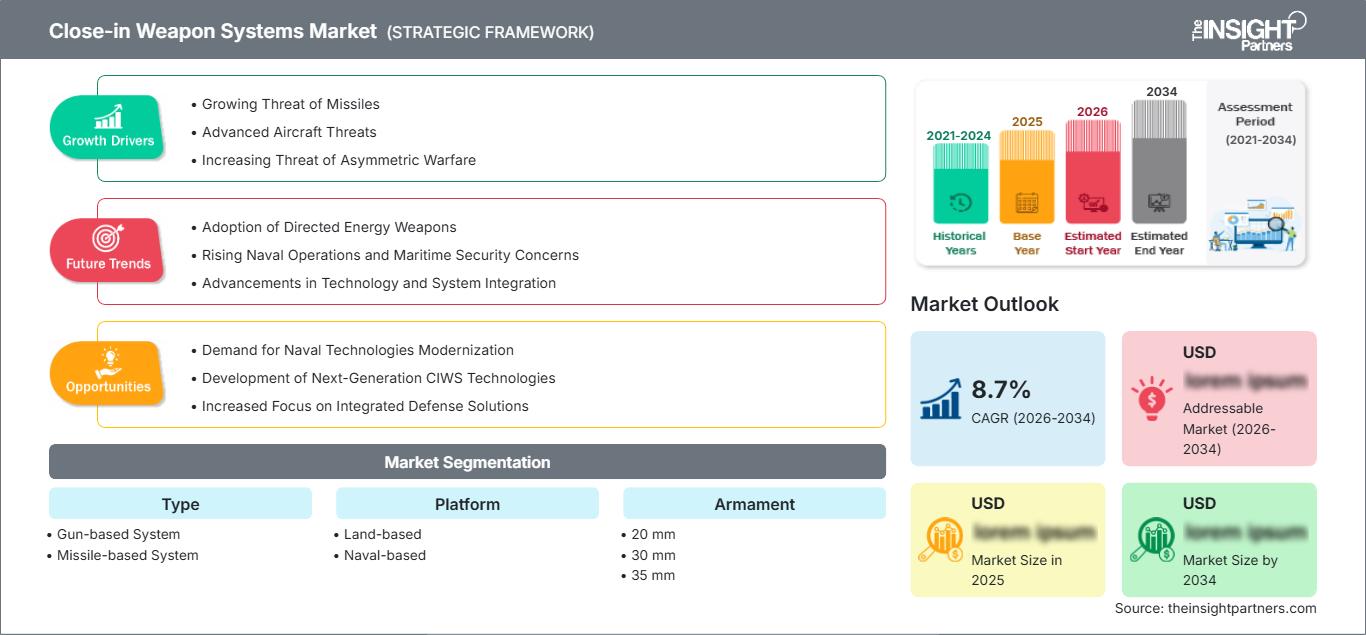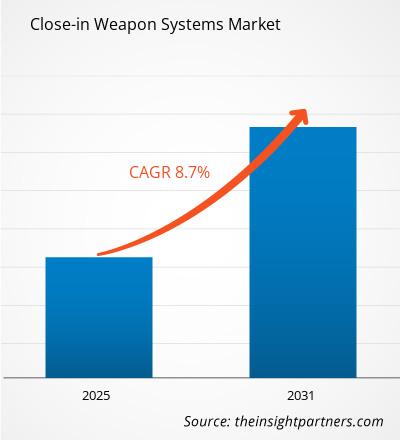The marché des systèmes d’armes rapprochés devrait croître à un taux de croissance annuel composé de 8,7 % entre 2026 et 2034. Les conditions du marché continuent d’évoluer, ouvrant de nouvelles opportunités pour les parties prenantes. Le paysage global reflète une progression stable et un potentiel de croissance à long terme.
The rapport est segmenté par type (système basé sur les canons, système basé sur les missiles) ; Plateforme (terrestre, navale) ; Armement (20 mm, 30 mm, 35 mm, 40 mm, Autres) ; Technologie (radar, guidage actif, guidage passif, infrarouge, autres). L’analyse mondiale est encore détaillée au niveau régional et des grands pays. Le rapport propose la valeur en USD pour l’analyse et les segments ci-dessus.
Purpose du rapport Report
The Close-In Weapon Systems Market par The Insight Partners vise à décrire le paysage actuel et la croissance future, les principaux facteurs moteurs, les défis et les opportunités. Cela fournira des informations à divers acteurs métier, tels que :
- Technology Fournisseurs/Fabricants : Comprendre l’évolution des dynamiques du marché et connaître les opportunités de croissance potentielles, leur permettant de prendre des décisions stratégiques éclairées.
- Investors : Réaliser une analyse complète des tendances concernant le taux de croissance du marché, les projections financières du marché et les opportunités existantes sur toute la chaîne de valeur.
- Organismes de régulation : Réguler les politiques et surveiller les activités sur le marché dans le but de minimiser les abus, préserver la confiance et la confiance des investisseurs, et préserver l’intégrité et la stabilité du marché.
Close-In segmentation du marché des systèmes d’armes de type
- Gun System
- System
Platform
- Land-based
- Naval-based
Armament
- 20 mm
- basé sur les missiles 30 mm
- 35 mm
- 40 mm
- Others
Technology
- Radar
- actifs Homing
- passifs Homing
- Infrared
- Others
Vous bénéficierez d’une personnalisation sur n’importe quel rapport - gratuitement - y compris des parties de ce rapport, ou une analyse au niveau du pays, un pack de données Excel, ainsi que de profiter d’offres exceptionnelles et de réductions pour les start-ups et les universités
Marché des systèmes d'armes rapprochées: Perspectives stratégiques

-
Obtenez les principales tendances clés du marché de ce rapport.Cet échantillon GRATUIT comprendra une analyse de données, allant des tendances du marché aux estimations et prévisions.
Facteurs de croissance du marché des systèmes d'armes rapprochées
- Menace croissante des missiles : La menace croissante des attaques de missiles, due à l'augmentation soudaine des acquisitions de missiles et de roquettes d'artillerie dans différentes régions, est l'un des principaux facteurs de croissance du marché des systèmes d'armes rapprochées.
- Menaces liées aux aéronefs de pointe : Le déploiement croissant d'aéronefs de combat et de soutien de nouvelle génération est un autre facteur majeur favorisant le déploiement de systèmes d'armes rapprochées sur différentes plateformes terrestres et navales.
- Menace croissante de la guerre asymétrique : La menace croissante de la guerre asymétrique est un moteur important pour le marché des systèmes d'armes rapprochées (CIWS). À mesure que les conflits évoluent, les forces militaires sont confrontées à des menaces non conventionnelles émanant d'acteurs non étatiques, tels que les insurgés et les groupes terroristes, qui utilisent diverses tactiques et technologies. Les CIWS offrent une défense essentielle contre ces menaces en constante évolution, notamment en milieu urbain ou lors de combats rapprochés. La reconnaissance croissante du besoin de solutions de défense rapprochée efficaces stimule les investissements des forces armées du monde entier dans les technologies CIWS.
Tendances futures du marché des systèmes d'armes rapprochées
- Adoption des armes à énergie dirigée : L'adoption croissante d'armes à énergie dirigée, telles que les armes laser, pour les opérations de combat rapproché est l'un des facteurs susceptibles de créer de nouvelles opportunités pour les fournisseurs de systèmes d'armes rapprochées dans les années à venir.
- Intensification des opérations navales et préoccupations en matière de sécurité maritime : L'intensification des opérations navales et les préoccupations en matière de sécurité maritime sont des facteurs clés de la croissance du marché des CIWS. Face aux tensions croissantes dans les eaux internationales et à l'importance accrue accordée à la sécurisation des routes commerciales maritimes, les forces navales ont besoin de systèmes de défense efficaces pour protéger les navires contre les attaques potentielles, notamment les frappes de missiles et les menaces de drones. Les CIWS sont des composantes essentielles des stratégies de défense navale, garantissant la capacité des navires à se défendre contre les menaces à courte portée. À mesure que les opérations navales s'étendent et évoluent, la demande de solutions CIWS avancées continuera de croître.
- Progrès technologiques et d'intégration des systèmes : Les progrès technologiques et l'intégration des systèmes stimulent l'innovation sur le marché des systèmes d'armes de proximité (CIWS). Le développement de capteurs avancés, de l'automatisation et de l'intelligence artificielle permet aux CIWS de fonctionner plus efficacement et avec une plus grande précision. L'intégration des CIWS aux systèmes de défense existants permet une meilleure connaissance de la situation et des temps de réponse plus rapides aux menaces. Alors que les forces armées cherchent à moderniser leurs arsenaux et à améliorer leur efficacité opérationnelle, la demande en solutions CIWS technologiquement avancées va croître, créant ainsi des opportunités pour les fabricants de ce secteur.
Opportunités du marché des systèmes d'armes de proximité
- Demande de modernisation des technologies navales : La demande croissante de modernisation des flottes navales et des technologies connexes est l'un des principaux facteurs favorisant le déploiement de systèmes d'armes de proximité sur différentes plateformes navales, notamment les frégates, les corvettes, les destroyers et les porte-avions.
- Développement des technologies CIWS de nouvelle génération : Le développement des technologies CIWS de nouvelle génération représente une opportunité majeure sur le marché des systèmes d'armes de proximité (CIWS). Face à l'évolution des menaces, les forces armées recherchent des systèmes avancés capables d'offrir des capacités accrues, telles qu'un ciblage amélioré, des temps de réponse plus rapides et une plus grande précision. Les innovations dans des domaines comme les armes à énergie dirigée, les lasers à haute énergie et les canons électromagnétiques offrent des perspectives prometteuses pour l'avenir des CIWS. En investissant dans la recherche et le développement de ces technologies de pointe, les fabricants peuvent se positionner comme leaders du marché et répondre à la demande croissante de systèmes de défense plus performants. L'accent mis sur les solutions de défense intégrées offre aux fabricants de CIWS l'opportunité d'élargir leur gamme. Les opérations militaires modernes exigent des systèmes fonctionnant de manière parfaitement intégrée, renforçant ainsi l'efficacité globale face aux menaces multiformes. En proposant des CIWS intégrables à d'autres systèmes de défense – tels que les radars, les systèmes de commandement et de contrôle et les technologies de surveillance – les fabricants peuvent créer des solutions complètes répondant aux besoins complexes des forces armées. Cette intégration permet une meilleure connaissance de la situation et une efficacité opérationnelle accrue, faisant des CIWS un élément essentiel des stratégies de défense modernes.
Marché des systèmes d'armes de combat rapproché
Les analystes de The Insight Partners ont analysé en détail les tendances régionales et les facteurs influençant le marché des systèmes d'armes de proximité tout au long de la période prévisionnelle. Cette section aborde également les segments et la répartition géographique du marché de la gestion des troubles du rythme cardiaque en Amérique du Nord, en Europe, en Asie-Pacifique, au Moyen-Orient et en Afrique, ainsi qu'en Amérique du Sud et centrale.
Marché des systèmes d'armes de combat rapproché Report Scope
By Plateforme- terrestre
- navale
- 20 mm
- 30 mm
- 35 mm
- 40 mm
- Autres
- Radar
- Guidage actif
- Guidage passif
- Infrarouge
- Autres
- Royaume-Uni
- Allemagne
- France
- Russie
- Italie
- reste de l'Europe
- Chine
- Inde
- Japon
- Australie
- reste de l'Asie-Pacifique
- Brésil
- Argentine
- reste de l'Amérique du Sud et centrale
- Afrique du Sud
- Arabie saoudite
- Émirats arabes unis
- reste du Moyen-Orient et de l'Afrique
Attribut de rapport Détails Taille du marché en 2025 US$ XX Million Taille du marché par 2034 US$ XX Million TCAC mondial (2026 - 2034) 8.7% Données historiques 2021-2024 Période de prévision 2026-2034 Segments couverts By Type - Système à base de canons
- Système à base de missiles
Régions et pays couverts Amérique du Nord - États-Unis
- Canada
- Mexique
Leaders du marché et profils d'entreprises clés - BAE Systems
- Denel Land Systems
- General Dynamics Ordnance and Tactical Systems
- Leonardo SpA
- MBDA, Inc.
- Northrop Grumman Corporation
- Raytheon Company
- Rheinmetall AG
- Thales Group
Densité des acteurs du marché des systèmes d'armes de proximité : comprendre son impact sur la dynamique commerciale
The Marché des systèmes d'armes de combat rapproché is growing rapidly, driven by increasing end-user demand due to factors such as evolving consumer preferences, technological advancements, and greater awareness of the product's benefits. As demand rises, businesses are expanding their offerings, innovating to meet consumer needs, and capitalizing on emerging trends, which further fuels market growth.

- Obtenez le Marché des systèmes d'armes rapprochées Aperçu des principaux acteurs clés
Points clés de vente
- Couverture exhaustive : Ce rapport analyse en détail les produits, services, types et utilisateurs finaux du marché des systèmes d'armes rapprochées, offrant ainsi une vision globale.
- Analyse d'experts : Ce rapport repose sur une connaissance approfondie du secteur et des analystes.
- Informations actualisées : Grâce à sa couverture des informations et tendances les plus récentes, ce rapport garantit la pertinence de vos analyses.
- Options de personnalisation : Ce rapport peut être personnalisé pour répondre aux besoins spécifiques de vos clients et s'adapter parfaitement à leurs stratégies commerciales.
Ce rapport d'étude de marché sur les systèmes d'armes rapprochées peut donc vous aider à décrypter et comprendre le contexte sectoriel et les perspectives de croissance. Malgré quelques points à améliorer, les avantages de ce rapport l'emportent généralement sur les inconvénients.
- Analyse historique (2 ans), année de base, prévision (7 ans) avec TCAC
- Analyse PEST et SWOT
- Taille du marché Valeur / Volume - Mondial, Régional, Pays
- Industrie et paysage concurrentiel
- Ensemble de données Excel
Rapports récents
Témoignages
Raison d'acheter
- Prise de décision éclairée
- Compréhension de la dynamique du marché
- Analyse concurrentielle
- Connaissances clients
- Prévisions de marché
- Atténuation des risques
- Planification stratégique
- Justification des investissements
- Identification des marchés émergents
- Amélioration des stratégies marketing
- Amélioration de l'efficacité opérationnelle
- Alignement sur les tendances réglementaires






















 Obtenez un échantillon gratuit pour - Marché des systèmes d'armes rapprochées
Obtenez un échantillon gratuit pour - Marché des systèmes d'armes rapprochées